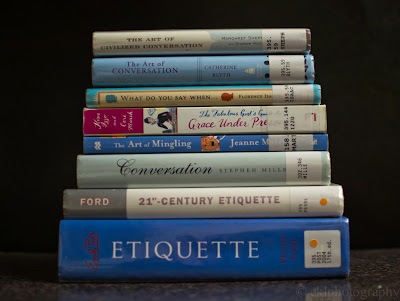Emily Post's Etiquette- Etiquette focuses on how to be polite and interact appropriately in any situation. The seminal work on traditional etiquette is perhaps my favourite reference out of all that I read through because it takes a more conservative view of manners and proper conduct. Sadly, the young men whom I ran some of Post's points past were more of the opinion that the "liberated woman" doesn't need the door held, her dinner paid for, or any sort of special consideration. She is equal, therefore she is one of of the guys! Mais non, the liberated woman just doesn't want to do all the damn dishes herself. Again.
Grace Under Pressure- This is the book of tactics for those situations you'd never admit to being in. Pulling your reputation back together after a mishap at the company party, getting by at an ex's wedding, and generally how to be gracious and sensitive no matter what. On conversation: a good section on how to start conversations, balancing questions and responses, listening (which makes all the difference when it comes time to reply), getting out of bad small talk, insults, and introducing yourself to strangers. Comes with entertaining anecdotes and scandal (clearly the selling point: this would never be me!).
21st Century Etiquette- Frankly, don't bother with this one. Outdated references to electronic mail and chatrooms, "teens" as children, slightly condescending "quizzes" at the ends of chapters and generally a bit simplistic. And there wasn't much on conversation.
What do you say when...- More quizzes. I suppose this is a style, as if it were a workbook, but I don't love it. Also a more traditional viewpoint with some good thoughts, and short, so a quick read. There's a good section on romantic meetings that also applies to platonic interactions and meeting new people. Worth it because the book is dedicated to conversation.
The Art of Mingling- Finally, we get past some of the more clichéd approaches (Haven't I seen you somewhere before?) to ideas on how to continue the conversation. Some of the ideas will sound pretty awkward ("This party is a virtual utopia" comes from the a-z list of words to build from when at a loss), but there are plenty such as watching from afar with another wall flower, asking a group a random question to poll responses and start a debate and so on. Kind of dorky to be seen with, but essentially quite useful.
Conversation: A History of a Declining Art- Certainly this is the most expansive and in-depth of all those I checked out... which unfortunately means I did not have time to read it in its entirety. However, I can say that having skimmed a bit, it looks to be perhaps more useful than any of the aforementioned because not only does it include methods from historical conversationalists (hello, Socrates?), but it's actually worth talking about the subject matter when you're done. Will take this one out later to read in full.
Then we come to The Art of Conversation and The Art of Civilized Conversation. Different authors and publishers, but you can just see the expression on the face of the former when she discovered the latter. These are both dense, full of lists, do's and dont's and bullets. The first, however, has the following passage:
"In the 1960s... computer pioneer Joseph Weizenbaum created Doctor, a software program that adapted a psychotherapy technique for bouncing back patients' statements as questions:
User: I have been rather depressed lately.One morning he was appalled to discover his transfixed secretary at a computer, unspooling her sorrows into Doctor's clunky, copycat code. ...So the thought that an echo is sufficient to convince us we're being listened to, that the bogus Doctor could seduce the secretary, carries the degrading suggestion that much of human complexity—those worries and wonders we store up and long to share—may also be illusory, empty, and that we are mere bundles of reactions, mysterious and meaningful only to us."
Computer: Are you depressed often?
User: Yes, almost all the time.
Computer: Why do you say yes almost all the time?
User: Right now I feel like I could cry.
Computer: Is it because right now you feel like you could cry that you came to me?
Thanks to the Arlington VA public library for having all these books and putting them on hold for me.


Good roundup. The Doctor's robotic response device is reminiscent of the library world's "reference interview" in which the librarian elicits greater and greater detail from the patron about what they are looking for by essentially parroting them. P: "I want a book about dogs." L: "So you want a book about dogs." Amazingly, in the examples, the patron never hauls off and whaps the librarian.
ReplyDelete